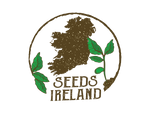In late Summer/Autumn, there are lots of flowers that produce their seeds so they can live on for future generations. When the weather is dry, it is a perfect time to harvest some of the easily harvested flower seeds. Dry plants make it easy to harvest seeds.
This post will focus on three varieties that are simple to harvest seeds from, to give you an idea of how to do it. The varieties are poppies, sunflowers and French marigolds (Tagetes).
If you want to try harvesting seeds from these plants, you’ll need to find the plants growing somewhere if you didn’t grow them yourself this year. You might have a friend or family member who has grown them, or they might be growing in the flower beds of your local community..
French Marigolds (Tagetes)
Saving the seeds from French Marigolds could not be easier once the heads of the flowers are rotted and dry. If you look at the picture below, you’ll see that the head is nice and brown. When it’s like this, the seeds are ready to be easily removed. The first step is to find a head that looks like this.
The second step is to simply pinch the top of the rotted head with your fingers and remove the seeds.

You can then clean the chaff from them if you wish. Store them for planting next Spring, or put them in the ground now. That’s it!
Poppies
Poppies are very easy to save the seed from once the weather is dry. If you look at the below picture, you'll see a ripe poppy seed pod. You'll know it's ripe as it will be yellow and starting to rot. If you give it a shake, you will also hear the seeds rattling around inside it.
All you have to do then is cut the seed pod off, and cut the top off:

and you should then find an abundance of free poppy seeds inside!
Sunflowers
If you planted sunflowers early this year, they will most likely be starting to die off now. Sunflower seed saving is easy, but it requires a little more effort than poppies.
Below you can see a rotted Velvet Queen sunflower head. Behind all of the black florets is where all of the new seed is growing. When the petals around the edges of the black florets are yellow and rotted as can be seen below, the seeds are ripe to harvest. If the petals around your sunflower head are still a little green, let them dry out and rot a bit more before harvesting the seed.
The next thing to do is pull all of the florets and seeds off of the sunflower head as can be seen below. They should be almost falling off themselves with little effort if the seeds are ripe. If the heads are not fully rotted, you can cut the heads off the plants and hang them in the greenhouse/shed for a while until they dry out and ripen more.
After that, seperate the seeds from the florets and anything else that comes off the sunflower. This can be a little tedious! Below is what you will be left with.
Let the seeds dry out for a few of days in a dry spot in the house. Then put them in an envelope and label them, so you know what they are when you go to plant them next year.
Conclusion
Hopefully this might give you a taste for flower seed saving, if it's not something you've already tried. If the varieties above aren't in your area, you can give it a go with other varieties. Once the flowers are starting to rot, you might find it intuitive as to where the new seeds are. Generally they are located where the flower head was, or in a berry/fruit or pod/bud on the flower.

